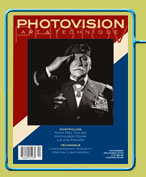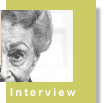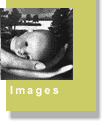A Conversation with Ruth Bernhard
Interview by Donna Conrad
From Vol. 1 No. 3
| Ruth Bernhard’s life has been based on saying “yes” to everything. Now in her 95th year, her wisdom and artistic expression is still flourishing. As with every great artist, Ruth’s work is only the outward expression of her vision. The true genius; the vital essence, that elevates her work from the mundane to a meaningful expression of human nature lies in her inner vision, her connection to life and the creative spirit.
Born in Berlin on October 14, 1905, Ruth began her photographic career in 1928, one year after joining her artist father in New York City. She worked as a photographer’s assistant for six months, and with $90 severance pay in her pocket, bought an 8x10 camera from a friend and struck out on her own. She was already an established commercial photographer in New York when her life took a dramatic turn in 1935, after a chance meeting with Edward Weston. “When I saw his work I was so deeply moved I cried. I hadn’t realized there were photographers who were artists. I had always thought photography was photography, but photography was not art! I thought photography was only for fashion and the commercial world. When I met Edward, however, I realized photography could be damn serious. Meeting him gave me an entirely new attitude about what I was doing — what I could be doing!” Displaying an independence and willingness to defy social traditions, evident throughout her life, Ruth left New York in 1936 and moved to Los Angeles with the intention of studying photography under Edward Weston. However, by the time she arrived, Edward had move to Carmel, California. Due to financial considerations, Ruth was unable to follow and so settled in Hollywood to pursue commercial photography and explore the artistic potentials of the medium. Despite her disappointment at the time, she considers this turn of events one of the gifts she has received in life, “You see, I was much too interested in being Edward’s student and since I didn’t have that chance, I became a photographer instead!” After living in Hollywood for several years Ruth moved back to New York, where she discovered a love of seashells, and her innate talent for capturing their delicacy and beauty on film. In 1943, with $40 and a one-way ticket, she left New York for Sanivol Island and the annual seashell show that took place each year. Her love of the subject and her talent won out and she began to photograph shells on a commercial basis. Making enough money to return to California, Ruth took up residence once again in Hollywood and developed a commercial photography business, all the while maintaining her close friendship with Edward Weston. Ruth moved to San Francisco in 1953 where she met and formed meaningful friendships with many great photographers such as Dorthea Lange, Imogen Cunningham, Morley Baer, Minor White and Ansel Adams. Due to her proximity to Carmel and Monterey she was able to spend more time with Edward Weston and also visit good friend, fellow photographer and philosopher, Wynn Bullock. Ruth Bernhard is the last surviving member of the original West Cost School of photographers who blazed a path in the world of black-and-white, helping to establish photography as an undisputed art form. Hers has been an adventurous life filled with ups and downs, but always one of enthusiasm and creativity. During this interview we will not be discussing chemistry, darkroom technique, cameras, film, or lighting. These aspects of Ms. Bernhard’s work have appeared in print numerous times over the last seventy years. Instead we will explore the essence of Ruth’s vision, her muse, her creative history, her loves and her passions; in life and in art. We will strive to peer behind the pristine images of teapots and Spanish dancers; to perhaps gain some insight into the soul of the woman who has inspired photographers and non-photographers with her visions of beauty and nobility; visions that allow the viewer to behold the world as a place of wonder, excitement, possibility and most of all, as a gift to be treasured. |
|




